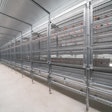
The welfare of hens is a very important concern for producers and also an area where consumers have an opinion, often without much knowledge. Where consumers are concerned, cages are viewed unfavorably with alternatives seen as being much more welfare friendly.
At the international level, one of the objectives of the World Organization for Animal Health (OIE) is to improve the health and welfare of animals. The OIE publishes codes that serve as global standards, and several chapters deal with animal welfare and production systems. However, there is no chapter addressing the welfare of laying hens and production systems.
What is layer welfare?
The definition of welfare for laying hens is complex and multifactorial, and often differs depending on the parties involved.
For some, welfare is only the possibility to express natural behaviors such as perching or nesting. For others, welfare means more than just expressing natural behaviors and must include functional aspects, such as nutrition or health. Most animal welfare specialists now recognize the multifactorial definition of welfare and the importance of four key areas: nutrition, environment, health and behavior, all having an impact on the well-being of hens.
To cage or not to cage?
Conventional cages remain the dominant housing system for hens around the world.
Although conventional cages guarantee good hygiene, health and low mortality, restriction of some natural behaviors, such as perching or nesting, have led to the search for alternatives. For example, since 2012, only cages equipped with a nest, perches and a scratching area are allowed in the European Union.
Today, more alternative cage-free systems are used and these allow hens more opportunities to express natural behaviors, yet these alternatives are not without welfare, and other, issues.
Dominant hens can easily prevent other birds from accessing perches or nests, and aggressive behaviors are more common. Bone fractures, especially of the keel bone, are more frequent when birds misjudge the distance between perches or to the floor. In a study in Canada, the incidence of fracture of the keel bone was twice as high in cage-free systems than in conventional cages.
The quality of the air, in terms of dust particles and ammonia levels, is also more variable in cage-free systems. In the U.S., a field study showed that cumulative mortality at 78 weeks in an aviary system was more than double that in either conventional or enriched cages. Mortality in free-range systems was also higher than in any other housing systems.
Health benefits questionable
One of the basic principles of welfare is the close relationship between welfare and good health. If consumers imagine cage-free systems as a few hens casually walking through green pastures, the reality is quite different.
A meta-analysis of 14 studies with free-range hens showed less than 50 percent of the flock going outside, and instances were recorded of less than 10 percent of the birds outside. In addition, the distribution of the birds outside is not uniform and most birds stay near the barns.
This causes a more intensive use of the range near the barns, increasing the risks for parasites and the accumulation of nitrogen and phosphorus in soils. The use of the range depends also on the climatic conditions, with fewer birds outside if windy, rainy or warm (temperature above 17 C).
Access to the range also increases the risks of parasites, such as coccidia, roundworms and red mites. Finally, wildlife predators greatly impact on the welfare of free-range birds. A study conducted last year at the University of California-Davis showed that the main causes of mortality for free-range hens were predation (52 percent), feather pecking and cannibalism (20 percent) and diseases (16 percent).
We have now more experience with alternative housing systems (furnished cages, aviary and free-range) in Europe and North America, in experimental and field studies. We know that different housing systems have the potential to impact differently the four aspects of animal welfare.
New systems must be tried and tested first and one must consider the possible trade-offs during the decision process. The effective management of critical situations during the life of a flock will always be more important than the type of system used.

Cage-free systems may allow more opportunities to express natural behavior but are not without welfare issues. | Vincent Guyonnet
Productivity impact
Type of housing system has an impact on productivity. If feed conversion was comparable between conventional and enriched cages, a study in the U.S. showed that feed conversion was 4 percent higher in aviaries.
In the U.K., egg production was reduced by 4.8 percent in barns and by 7 percent in free-range systems when compared with conventional cages. In addition, the daily feed consumed was 8 percent and 13 percent higher, in barns and aviaries, respectively. All these observations contribute to a higher cost of egg production in alternative systems.
Carbon footprint
What about the impact of housing systems on the carbon footprint of eggs?
In studies in Australia, The Netherlands and the U.K., the greenhouse gas emissions in free-range systems were found to be much higher than in conventional cage systems, with an increase of between 15.7 percent and 23.1 percent. Similar results were observed when comparing barn cage-free systems and conventional cages, with emissions between 10.2 percent and 18.1 percent higher in cage-free systems.
Egg production contributes only 2.8 percent of the total greenhouse gas emissions of the global livestock sector. Although these emissions are low, there are many opportunities to reduce the carbon footprint of eggs. The adoption of best management practices and the selection of a housing system have a significant impact on the greenhouse gas emissions of egg production.
The sustainability of egg production relies on social, environmental and economic dimensions. On the social front, the welfare of hens must be balanced with the health and well-being of farm workers, food safety and nutrition and food security.
On the environmental front, we have many studies demonstrating the positive effects of cage systems on the use of energy, water and other natural resources, all impacting on the intensity of greenhouse gas emissions. In addition to being the best source of proteins, eggs have also the lowest carbon footprint per kilogram of proteins produced.
On the economic front, the increase in cost of production, varying between 6 percent and 40 percent with alternative housing systems, will have a negative effect on price and consumer demand.
Because eggs are one of the best and least expensive sources of quality proteins, we must ensure that we will continue to deliver on our promises to consumers in terms of quality nutrition at an affordable price.

In free-range production, birds that leave the house tend to stay close by, which increases health risks in the area used. | Vincent Guyonnet
The market will dictate the future of cage-free eggs
www.WATTAgNet.com/articles/26320
Downloadable PDF resource for cage-free eggs available
Check out a new collection of exclusive articles, blogs and infographics on Cage-free Eggs: Hen Welfare and Housing Challenges. Written by trusted WATT Global Media editors and industry experts, this report will equip egg producers and marketers with information to help them make critical business decisions. Available for purchase now.















